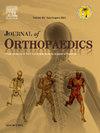Mechanical stimulation in 2D: A potent accelerator of matrix mineralization in ATDC5 chondrogenic cells
IF 1.5
Q3 ORTHOPEDICS
引用次数: 0
Abstract
Background
Matrix mineralization is a key process in endochondral ossification and cartilage maturation. While optimized biochemical protocols using ATDC5 chondrogenic cells have shortened mineralization timelines, the role of mechanical stimulation in enhancing this process remains underexplored. This study investigates whether dynamic mechanical stimulation in 2D monolayer cultures can accelerate mineralization and influence extracellular matrix (ECM) composition.
Methods
ATDC5 cells were cultured on PDMS membranes coated with collagen and subjected to cyclic tensile strain (12 % at 0.05 Hz for 1 h/day) using a uniaxial bioreactor over 5 days. The culture protocol included supplementation with β-glycerophosphate and ascorbic acid. Mineralization and ECM production were assessed at days 7, 17, and 23 using Alizarin Red and Alcian Blue staining. SEM/EDX confirmed calcium-phosphate deposition. A phenomenological finite element model was developed to correlate mechanical stimuli with hypertrophy using the osteogenic index.
Results
Mechanical stimulation led to a 32 % increase in Alizarin Red staining compared to controls (P < 0.001), indicating faster mineralization. GAG production was reduced under mechanical loading (P < 0.05), consistent with early mineralization. SEM/EDX confirmed more uniform mineral deposition in stimulated samples. Morphologically, stimulated cells aligned along the loading axis and displayed a nearly 10-fold increase in hypertrophic cell area. The numerical model showed elevated osteogenic index values and stress peaks in the chondrocyte membrane under mechanical loading.
Conclusions
Dynamic tensile stimulation in 2D culture significantly accelerates ECM mineralization in ATDC5 cells. This effect appears to be mediated through enhanced chondrocyte hypertrophy and alignment of ECM components. The combined use of mechanical and biochemical cues provides a promising strategy for optimizing in vitro models of endochondral ossification and developing tissue engineering therapies.
二维机械刺激:ATDC5软骨细胞基质矿化的有效加速器
基质矿化是软骨内成骨和软骨成熟的关键过程。虽然使用ATDC5软骨细胞优化的生化方案缩短了矿化时间,但机械刺激在增强这一过程中的作用仍未得到充分探索。本研究探讨了二维单层培养物的动态机械刺激是否能加速矿化并影响细胞外基质(ECM)的组成。方法在胶原包被的PDMS膜上培养satdc5细胞,在单轴生物反应器中进行循环拉伸应变(12%,0.05 Hz, 1 h/d) 5 d。培养方案包括补充β-甘油磷酸酯和抗坏血酸。在第7、17和23天用茜素红和阿利新蓝染色评估矿化和ECM的产生。SEM/EDX证实有磷酸钙沉积。利用成骨指数建立了一个现象学有限元模型,将机械刺激与肥厚联系起来。结果机械刺激导致茜素红染色比对照组增加32% (P <;0.001),表明矿化速度更快。机械载荷降低了GAG产量(P <;0.05),与早期成矿一致。SEM/EDX证实了受激样品中更均匀的矿物沉积。形态学上,受刺激的细胞沿加载轴排列,肥厚细胞面积增加近10倍。数值模型显示,在机械载荷作用下,软骨细胞膜的成骨指数和应力峰值升高。结论动态拉伸刺激可显著促进ATDC5细胞ECM矿化。这种作用似乎是通过增强的软骨细胞肥大和ECM成分的排列介导的。机械和生化线索的联合使用为优化体外软骨内成骨模型和开发组织工程治疗提供了一个有前途的策略。
本文章由计算机程序翻译,如有差异,请以英文原文为准。
求助全文
约1分钟内获得全文
求助全文
来源期刊

Journal of orthopaedics
ORTHOPEDICS-
CiteScore
3.50
自引率
6.70%
发文量
202
审稿时长
56 days
期刊介绍:
Journal of Orthopaedics aims to be a leading journal in orthopaedics and contribute towards the improvement of quality of orthopedic health care. The journal publishes original research work and review articles related to different aspects of orthopaedics including Arthroplasty, Arthroscopy, Sports Medicine, Trauma, Spine and Spinal deformities, Pediatric orthopaedics, limb reconstruction procedures, hand surgery, and orthopaedic oncology. It also publishes articles on continuing education, health-related information, case reports and letters to the editor. It is requested to note that the journal has an international readership and all submissions should be aimed at specifying something about the setting in which the work was conducted. Authors must also provide any specific reasons for the research and also provide an elaborate description of the results.
 求助内容:
求助内容: 应助结果提醒方式:
应助结果提醒方式:


